American Sabbatical 018: 9/21/96
Badlands and Buffalo
9/21...Badlands.
The sun shone on our backs as we spun rubber onto I-90 at Murdo on Saturday morning. We had sworn NO SUPER HIGHWAYS, at the start of this thing, but east-west on the high plains is all 75mph whichever route, and we’d set a goal to be in the Black Hills for the equinox. So we joined the transAmerican stream. Lots of Luminas and Saturns from Minnesota, and the big rigs rolling. And billboards. Had you forgotten about billboards? SEE THE 50 FOOT TALL T-REX AT WALL DRUG. But out here in the vast center billboards can’t begin to block the view , and they provide some comic relief to the limitless astonishment. It’s not that this Great American Desert is so empty. It’s simply too much. And too subtle. An infinite variety of beige. ALLIGATORS AT WALL DRUG. Time gets twisted out here. Billboards, 75mph, and half the cars are Fifties vintage. Motels have old Chevy motifs. 5 CENT COFFEE AT WALL DRUG. Maybe Eisenhower is still President. But bigger anachronisms were just over the horizon.
We made our first pit stop at an original prairie sod home a couple
named Brown had homesteaded in 19-ought-something, now maintained
as a local museum. It defines hardscrabble. If you squint your
eyes, those depression-era dustbowl figures are still struggling
against a ghostly wind here. The power of media images to persist
in time and place is eerie. Across Iowa and South Dakota there
were parties of Indians on horseback coming over the swells, mired
wagons with cursing emigrants in every creekbottom, and herds
of ghost buffalo dotting the tongue-tied distance. Too many TV
Westerns as a child?
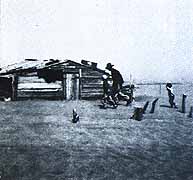
Dorothea Lang Photo
Then we were in the badlands, and completely out of time. Naked geology can do that to you. The bones of a million years thrust up in our faces to silence us. There is a solemn ritual pace to a stream of American Pilgrims seeing our National Sights. We rush to get there, then we entrain at 25mph, nod and smile at each other. Check out the license plates. This is one of our rituals of identification. We live in such a place. The badlands have resisted our urge to modify the landscape by their sheer alien-ness, so now we worship them by caravanning through with Kodaks. The intensity of windcarved sedimentary rock rising like a nightmare out of the pure horizontal disrupts your vision. So opened by the wideangle plains our eyes are dazzled by the orange and yellow intensities. We go around hushed like in a cathedral. Pilgrims in Winnebagos.
But the great equinocial equalizer, the big chief Hush Yo Mouth, was just ahead. We turned off Winnebago Way onto a dirt road south, back into rolling prairie, and lost our bearings completely. Tiptoeing over the washboard ruts we came up alongside four bull buffalo striding their majestic way across the seamless grassland. We rolled alongside them, creatures out of different times, until our trails diverged. You go looking for history and you might fall through the gap.
Open-mouthed we made more dust down the road, the beyond-old badlands now appearing on our left and the immensity on our right. Below us in Sage Creek valley we saw a campground hard-by the deepcut creek with its line of cottonwoods. Descending we were in a rolling sienna grassland dotted with dark clumps of cedar (or juniper). Round the bend the road was framed with two more bull bison, like the family estate gates of the west. Any road that leads between two buffalo, we decided had to be all right.
But the campground proved to be dry and dusty and full of flies under a hot sun. It was a horse campground, too, and they were fragrantly in residence. While we were debating staying in a magic, timeless place that promised an olfactory adventure with bugs, we grabbed our drawing materials and wandered down to the creek. Topping the bank we spooked a coyote, who stopped, looked, sped a few yards, stopped, looked, loped up the far bank, and, looking over his shoulder occasionally, made a serpent-trail across the far grassland. Right through a prairie-dog village, which set them to scattering and chattering. Here we were caught between the seasons and not sure which end is up.
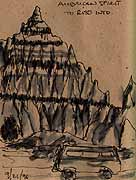
Badlands in Ink
But we decided to leave this otherness while the sun was still
high and meet our pledge to the Black Hills. “Are we nuts? Too
driven?..What ARE we looking for out here if it isn’t total immersion
in a past landscape?” we kept asking. Then we drove into the middle
of a herd of bison. Fixated by a handful on the right I almost
drove into one crossing from the left, who kicked up his heels
and scuttled in his heavyshouldered dance up the embankment. How
can an animal so ungainly-looking move with such majestic grace,
and sprint with such playfulness? So we rolled on, watching those
emblems of a lost time disappear in the billows. We were out of
film, of course.
When we got into the outskirts of Rapid City, in a Saturday evening
snarl, I was sure we’d lost our marbles, but I was wrong. Another
30 miles found us deep in the Custer State Park, camped in the
cool shade of ponderosa pines on the banks of a ululating brook,
singing a mountain song. We pitched our tent, chowed down, convinced
an armload of wet wood to make a fire, blew flute and sang cowboy
songs, while a halfmoon looked down through the smoke and needles.
What a way to celebrate the turn of seasons. Hope yours are turning
gracefully, too.
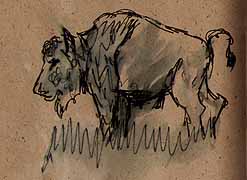
5¢
(Memo #18)
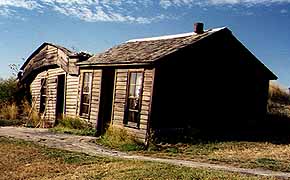
Prairie Homestead
Sept. 21 - Prairie Homestead
Who? prairie homesteaders
What? original sod house
Where? at entrance to Badlands park, South Dakota
when? lived in from 1890's to 1940's
How? homesteading
Topics: homesteading, Homestead Act 1862, sod houses, prairie
adaptation, open air museum, Great American Desert.
Questions: What was the impact of the Homestead Act? What was
life like on a Plains claim? How can a museum best convey the
reality of life in the past? How would you design a museum to
present the reality of your life in 1996?
We are seeing a great many museums in our travels. They are large and small, open and indoors, walk through and behind glass, with many different types of exhibits. The aim of each is to convey the facts about ways of life and people that no longer exist - Seneca Falls commemorates a convention, Cahokia tries to recreate a vast pre-Columbian city, the Prairie Homestead Museum tries to put us alone in a sod house on a claim in the early 1900s. And it succeeds.
The Prairie Homestead Museum is located near the Badlands National
Park
(an incredible place on its own) in central southern South Dakota.
The original sod house was built into a grassy slope leading down
to a small creek valley. Huge cottonwood trees and smaller shrubs
grow near the creek. The modern road winds down the shallow valley
and a dirt lane leads off it across a small bridge to the entrance
building which houses a gift shop and historical display .
Behind it, the homestead is a visual entity framed against the
sky. The house, barn, storage buildings, root cellar, farm equipment,
fences, outhouse are all there. Live chickens run across your
path and laundry (including red longjohns) hangs on the line.
When you stand near the roof of the house on the open prairie
looking down into the gully there’s nothing manmade to be seen
in other directions and the wind is a presence. This is a very
small place in a very large landscape. How could anyone survive
in this vast openness?
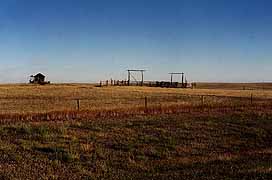
Prairie Corral
There are signs in front of each structure that seem informal, just a few facts on each, and they are unobtrusive. At the well, the sign says it’s sixty feet deep and in dry years only gave a few buckets of water a day. The sign by the root cellar noted that this structure was the only one that really had to be reconstructed since it had fallen in. The rest was as it was when it was last occupied (in the 1940’s !!). The original family had been followed by a bachelor who lived there until he died.
Maybe that’s why it was such a living place. It HAD been lived
in until recently and was maintained by people who had known the
last resident. Pictures in the exhibit show people in fairly modern
dress posing there. The dates and people connected the historical
building to today. The Plains were settled late in American history. We misunderstood
the whole ecosystem. When white settlers first encountered the
Plains they were nonplused. How could soil be any good for farming
if it couldn’t even grow trees? They dismissed the Plains as “The
Great American Desert” and took their wagon trains to Oregon ,
a proper farming land. In the 1830’s and 1840’s the northwest
filled up. In the 1850’s, remember, the focus of politics was
Kansas and Nebraska. The Plains really filled up in the years
after the Civil War. It was then that the Army (freed from full
time involvement in the Civil War) could subdue the Plains tribes
and make settlers safe.
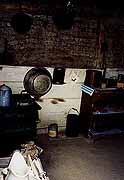
Inside the Homestead
The Homestead Act of 1862 was an incentive for farmers to settle on the Plains. If you were over 21, as a family or individual you could put down $18 for 160 acres. You needed to start making improvements immediately and to live there for five years. Then it was yours. (I still don’t know if women could or did stake claims on their own???). Later the rules were changed a little and you could plunk down only $14 at filing, have proof of six months’ residence and have 10 acres under plow to get your claim. Homesteaders said the government laid a bet, 160 acres for $18 that you would starve to death within 5 years!
This homestead was settled by the Browns, husband, wife, and son
who came in the early 1900’s. I was amazed that Mr. Brown was
55 when he staked this claim, I somehow thought the backbreaking
work was for younger men.
There are many books that describe the hard labor, loneliness,
heat and cold, crop failures and illness of life on a Plains claim.
Remember in Little House on the Prairie when Pa got caught in a snowstorm on his way back to the claim
from town? Other books...Joanna Stratton edited her grandmother’s
diary of early life. My Antonia describes immigrant claim settlers as well. All of it sounds
desperately hard.
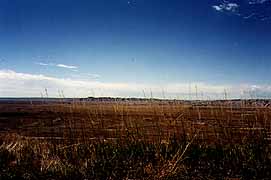
Badlands on Horizon
This homestead house is three rooms. The original sod house cut into the bank on the north side of the draw is two rooms, a front kitchen (about 15 feet square and six feet high) with two small windows cut above ground level, and a small back bedroom, just bigger than the double bed. There were roof beams covered by branches and sod. The walls clearly show the block of grassy sod cut and stacked and then daubed on the inside (with whitewash?). I imagined the labor of cutting the sod blocks and stacking up the walls. The floors are dirt and somewhat uneven. A small wood cook stove stands in the corner. The rooms are plainly furnished but have all the necessities, table and shelves and cupboards, bed and washbasin, wood bucket too. It looks as though the owner has just stepped out for a moment.
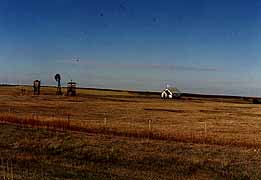
Little Church on the Prairie
Later on a another claimstaker’s small cabin was moved to the
spot and attached as a small neat living room complete with chairs
and sofa and bookshelves and small organ and pictures on the walls.
It has a wooden floor with rag rugs. A door was cut through to
the kitchen. It is a neat and comfortable small house ready for
immediate occupancy.
Outside things seemed barer. I went up the path by the house and stood next to the roof (the only small cactuses I saw in the whole state grew on the roof of the sod house). Again the sense of endless grassy distances. The barn and outbuildings are small rude buildings. A small area for a horse or cow is fenced in. The sod cellar has a few empty shelves. A very old car is stashed in one of the sheds (the sign said the claimstakers had not owned it). The farm machinery, the horse drawn plows and the cultivators and hay rakes, are probably better than the original owner used.The area is dotted with prairie dog holes which can easily sprain an ankle. My Antonia also mentions huge snakes, but I haven’t seen any.
It was a vivid and very real place. The modern gift shop building seems the intrusion.